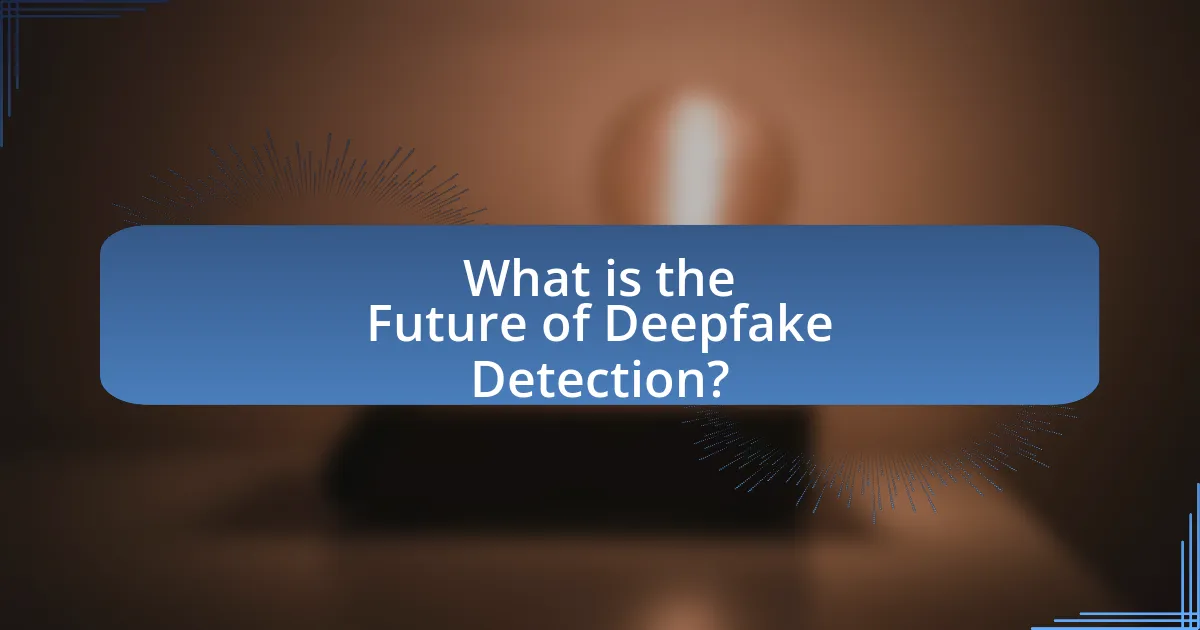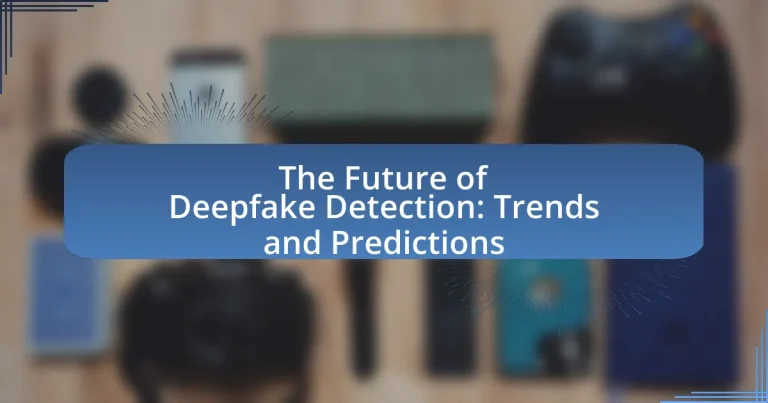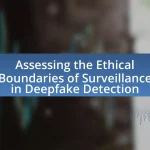The article focuses on the future of deepfake detection, emphasizing the role of advanced machine learning algorithms and real-time analysis in identifying manipulated media. It discusses the creation of deepfakes using artificial intelligence techniques, particularly Generative Adversarial Networks (GANs), and highlights the importance of detection in preventing misinformation and protecting privacy. Key trends shaping detection methods include the integration of multi-modal techniques, collaboration between tech companies and regulatory bodies, and the ethical considerations surrounding privacy and consent. The article also outlines current tools and technologies available for deepfake detection, as well as predictions for future advancements in this critical area.

What is the Future of Deepfake Detection?
The future of deepfake detection is expected to involve advanced machine learning algorithms and real-time analysis capabilities. As deepfake technology evolves, detection methods will increasingly rely on artificial intelligence to identify subtle inconsistencies in audio and visual content. Research indicates that the integration of multi-modal detection techniques, which analyze both visual and auditory signals, will enhance accuracy. For instance, a study published in 2021 by the University of California, Berkeley, demonstrated that combining deep learning with forensic analysis significantly improved detection rates of manipulated media. This trend suggests that as deepfake creation tools become more sophisticated, detection technologies will also advance, focusing on developing robust systems capable of countering misinformation and protecting digital integrity.
How are deepfakes created and why is detection important?
Deepfakes are created using artificial intelligence techniques, primarily through deep learning algorithms such as Generative Adversarial Networks (GANs), which enable the synthesis of realistic images and videos by training on large datasets of existing media. Detection of deepfakes is crucial because it helps prevent misinformation, protects individual privacy, and maintains the integrity of digital content, as evidenced by the increasing prevalence of deepfake technology in disinformation campaigns and its potential to cause reputational harm.
What technologies are used in the creation of deepfakes?
Deepfakes are primarily created using artificial intelligence technologies, specifically deep learning algorithms. These algorithms, particularly Generative Adversarial Networks (GANs), enable the synthesis of realistic images and videos by training on large datasets of existing media. GANs consist of two neural networks, a generator and a discriminator, that work in opposition to improve the quality of the generated content. Additionally, techniques such as autoencoders and convolutional neural networks (CNNs) are also employed to enhance the fidelity of the deepfake outputs. The effectiveness of these technologies has been demonstrated in various studies, highlighting their ability to produce highly convincing fake media.
What are the potential risks associated with deepfakes?
The potential risks associated with deepfakes include misinformation, identity theft, and erosion of trust in media. Misinformation can lead to the spread of false narratives, as deepfakes can convincingly alter reality, influencing public opinion and political outcomes. Identity theft occurs when individuals’ likenesses are manipulated to create fraudulent content, potentially damaging reputations and personal lives. Furthermore, the erosion of trust in media arises as audiences become skeptical of authentic content, making it difficult to discern truth from fabrication. According to a 2020 report by the Brookings Institution, deepfakes pose significant threats to democratic processes and societal stability, highlighting the urgency for effective detection methods.
What current trends are shaping deepfake detection?
Current trends shaping deepfake detection include the use of advanced machine learning algorithms, the development of real-time detection tools, and increased collaboration between tech companies and regulatory bodies. Advanced machine learning algorithms, such as convolutional neural networks, enhance the accuracy of detecting manipulated media by analyzing subtle inconsistencies in video and audio. Real-time detection tools are being prioritized to combat the rapid spread of deepfakes, allowing for immediate identification and response. Furthermore, collaboration between tech companies, like Facebook and Google, and regulatory bodies aims to establish standards and frameworks for deepfake detection, ensuring a unified approach to tackling misinformation. These trends reflect a proactive stance in addressing the challenges posed by deepfakes in various sectors, including media, security, and social platforms.
How is artificial intelligence influencing deepfake detection methods?
Artificial intelligence is significantly enhancing deepfake detection methods by employing advanced algorithms that analyze video and audio content for inconsistencies. These AI-driven techniques utilize machine learning models trained on vast datasets of authentic and manipulated media, allowing them to identify subtle artifacts and anomalies that human reviewers might miss. For instance, research published in 2020 by the University of California, Berkeley, demonstrated that deep learning models could achieve over 90% accuracy in detecting deepfakes by focusing on facial movements and audio-visual synchronization. This integration of AI not only improves detection rates but also enables real-time analysis, making it a crucial tool in combating the proliferation of deepfake technology.
What role do social media platforms play in deepfake detection?
Social media platforms play a crucial role in deepfake detection by implementing advanced algorithms and community reporting systems to identify and mitigate the spread of manipulated content. These platforms utilize machine learning techniques to analyze video and audio for inconsistencies that may indicate deepfakes, such as unnatural facial movements or mismatched audio. For instance, Facebook has developed a deepfake detection tool that uses artificial intelligence to flag potentially manipulated videos before they go viral, thereby reducing misinformation. Additionally, platforms encourage user engagement in reporting suspicious content, which enhances the detection process through collective vigilance. This dual approach of technological innovation and community involvement is essential for maintaining the integrity of information shared online.
What predictions can be made about the future of deepfake detection?
Predictions about the future of deepfake detection indicate that advancements in artificial intelligence and machine learning will significantly enhance detection capabilities. As deepfake technology evolves, detection algorithms will likely incorporate more sophisticated techniques, such as neural networks trained on vast datasets of authentic and manipulated media. Research from the University of California, Berkeley, highlights that as deepfake generation tools become more accessible, the demand for robust detection methods will increase, leading to the development of real-time detection systems capable of identifying deepfakes with high accuracy. Furthermore, collaboration between tech companies and regulatory bodies is expected to foster the creation of standardized detection frameworks, improving the overall reliability of deepfake identification.
How might advancements in technology impact detection accuracy?
Advancements in technology significantly enhance detection accuracy by improving algorithms and increasing computational power. For instance, machine learning models, particularly deep learning techniques, have shown a marked increase in their ability to identify subtle inconsistencies in deepfake videos, achieving accuracy rates above 90% in some studies. Research conducted by the University of California, Berkeley, demonstrated that advanced neural networks can analyze pixel-level details and temporal inconsistencies that traditional methods often miss, thereby increasing the reliability of detection systems.
What ethical considerations will arise in the future of deepfake detection?
Ethical considerations in the future of deepfake detection will primarily revolve around privacy, consent, and misinformation. As deepfake technology advances, the potential for misuse increases, leading to violations of individual privacy rights when personal images or videos are manipulated without consent. Furthermore, the challenge of distinguishing between authentic and fabricated content raises concerns about the spread of misinformation, which can undermine trust in media and institutions. A study by the Brookings Institution highlights that 70% of Americans are concerned about the impact of deepfakes on public trust, emphasizing the need for ethical frameworks to address these issues. Additionally, the development of detection technologies must balance the need for security with the risk of infringing on civil liberties, creating a complex ethical landscape that requires careful navigation.
How can we prepare for the evolving landscape of deepfake detection?
To prepare for the evolving landscape of deepfake detection, organizations should invest in advanced detection technologies and continuous training for personnel. Implementing machine learning algorithms that analyze video and audio for inconsistencies can enhance detection capabilities, as evidenced by research from Stanford University, which highlights the effectiveness of AI in identifying manipulated media. Additionally, fostering collaboration between tech companies, researchers, and policymakers can lead to the development of standardized detection protocols, ensuring a unified approach to combating deepfakes.
What best practices should organizations adopt for deepfake detection?
Organizations should adopt a multi-faceted approach for deepfake detection, which includes implementing advanced AI algorithms, conducting regular training for employees, and establishing clear protocols for verification. Advanced AI algorithms, such as those utilizing machine learning techniques, can analyze video and audio content for inconsistencies that indicate manipulation. Regular training for employees ensures that staff are aware of the latest deepfake technologies and can recognize potential threats. Establishing clear protocols for verification, including cross-referencing sources and utilizing forensic tools, enhances the organization’s ability to identify and respond to deepfake incidents effectively. These practices are supported by research indicating that organizations employing a combination of technology and human oversight significantly improve their detection capabilities.
How can individuals protect themselves from deepfake misinformation?
Individuals can protect themselves from deepfake misinformation by critically evaluating the sources of information and verifying content authenticity. This involves cross-referencing videos or images with reputable news outlets and using fact-checking websites to confirm claims. Research indicates that deepfake technology is advancing rapidly, making it increasingly difficult to distinguish between real and manipulated content; therefore, awareness of the existence and capabilities of deepfakes is crucial. Additionally, utilizing tools designed for deepfake detection, such as Deepware Scanner or Sensity AI, can help individuals identify altered media.
What are the implications of deepfake detection advancements for society?
Advancements in deepfake detection have significant implications for society, primarily by enhancing trust in digital media. As detection technologies improve, they can help mitigate the spread of misinformation and disinformation, which has been linked to social unrest and political polarization. For instance, a study by MIT found that false news spreads six times faster than true news on social media, highlighting the urgent need for effective detection methods. Furthermore, improved detection can protect individuals from identity theft and reputational harm, as deepfakes can be used maliciously to create misleading content. Overall, these advancements contribute to a more informed public and a safer digital environment.
How will deepfake detection affect trust in media and information?
Deepfake detection will enhance trust in media and information by providing tools to verify the authenticity of content. As deepfake technology becomes more sophisticated, the ability to detect manipulated media will reassure audiences that the information they consume is credible. Research indicates that 86% of people express concern about misinformation, highlighting the need for reliable detection methods. Effective deepfake detection systems can mitigate the spread of false narratives, thereby reinforcing public confidence in legitimate media sources.
What legal frameworks may emerge in response to deepfake technology?
Legal frameworks that may emerge in response to deepfake technology include regulations focused on misinformation, privacy rights, and intellectual property protection. As deepfakes can manipulate visual and audio content, governments may implement laws to penalize the creation and distribution of deceptive media, similar to existing laws against fraud and defamation. For instance, California enacted a law in 2019 that criminalizes the use of deepfakes to harm or defraud individuals, indicating a trend towards legislative action. Additionally, frameworks may evolve to address consent issues, requiring explicit permission for the use of an individual’s likeness in deepfake content, thereby enhancing personal privacy rights.
What tools and technologies are available for deepfake detection today?
Various tools and technologies are available for deepfake detection today, including machine learning algorithms, digital forensics techniques, and specialized software. Machine learning algorithms, such as convolutional neural networks (CNNs), analyze video and audio data to identify inconsistencies that indicate manipulation. Digital forensics techniques involve examining metadata and pixel-level analysis to detect alterations. Specialized software, like Deepware Scanner and Sensity AI, provides real-time detection capabilities and comprehensive analysis of media content. These tools leverage advancements in artificial intelligence and data analysis to enhance the accuracy and efficiency of deepfake detection, addressing the growing concerns surrounding misinformation and digital security.
What are the most effective software solutions for detecting deepfakes?
The most effective software solutions for detecting deepfakes include Deepware Scanner, Sensity AI, and Microsoft Video Authenticator. Deepware Scanner utilizes advanced machine learning algorithms to analyze video content for signs of manipulation, achieving high accuracy rates in identifying deepfakes. Sensity AI employs a combination of computer vision and deep learning techniques to detect synthetic media, providing real-time analysis and reporting capabilities. Microsoft Video Authenticator analyzes images and videos to assess their authenticity, offering a score that indicates the likelihood of manipulation. These solutions are backed by extensive research and development in the field of artificial intelligence, demonstrating their effectiveness in combating the growing threat of deepfake technology.
How can machine learning improve the detection of deepfakes?
Machine learning can improve the detection of deepfakes by utilizing advanced algorithms that analyze patterns and anomalies in video and audio data. These algorithms can identify inconsistencies in facial movements, voice modulation, and other subtle cues that are often overlooked by human observers. For instance, a study published in 2020 by the University of California, Berkeley, demonstrated that machine learning models could achieve over 90% accuracy in distinguishing between real and manipulated videos by training on large datasets of both types. This capability allows for the rapid and scalable detection of deepfakes, enhancing the reliability of content verification processes in various applications.
What steps can individuals take to stay informed about deepfake detection?
Individuals can stay informed about deepfake detection by regularly following reputable sources of information, such as academic journals, technology news websites, and organizations focused on digital media integrity. Engaging with platforms like the IEEE Transactions on Information Forensics and Security, which publishes research on detection techniques, provides insights into the latest advancements. Additionally, participating in online forums and webinars hosted by experts in the field can enhance understanding of emerging trends and tools. Following social media accounts of researchers and institutions dedicated to combating misinformation also helps individuals stay updated on new developments and best practices in deepfake detection.


